Water Status and Predictive Models of Moisture Content during Drying of Soybean Dregs Based on LF-NMR
Abstract
:1. Introduction
2. Materials and Methods
2.1. Materials and Instruments
2.2. Methods
2.2.1. Sampling and Treatment
2.2.2. Detection of Moisture Content
2.2.3. Determination of the Effective Moisture Diffusivity
2.2.4. Water Detection with LF-NMR
2.2.5. Prediction Model and Error Analysis
2.2.6. Data Processing
3. Results and Discussion
3.1. Drying Characteristics of Soybean Dregs
3.1.1. Moisture Content
3.1.2. Effective Moisture Diffusivity
3.2. Water Status during Drying of Soybean Dregs
3.3. Construction and Validation of Moisture Content Prediction Model
3.3.1. Relationship between LF-NMR Peak Area and Moisture Content
3.3.2. Relationship between the Gray Value of Proton Density and the Moisture Content
3.3.3. Prediction Error Analysis
4. Conclusions
Author Contributions
Funding
Institutional Review Board Statement
Informed Consent Statement
Data Availability Statement
Conflicts of Interest
Samples of the Compounds
References
- Pambudi, N.; Ardiyansyah, P.; Syivarulli, R.; Biddinika, M.; Syamsiro, M.; Kuncoro, I. Utilization of soybean dregs for solid fuel production through hydrothermal carbonization. Therm. Sci. 2021, 25, 4797–4803. [Google Scholar] [CrossRef]
- Callegaro, A.M.; Filho, D.; Brondani, I.L.; Silveira, M.; Rodrigues, L. Intake and performance of steers fed with soybean dreg in confinement. Semin. Cienc. Agrar. 2015, 36, 2055–2066. [Google Scholar] [CrossRef] [Green Version]
- Min, Q.; Liu, Y.; Zhang, G.; Xue, S.J.; Fan, H.; Yan, W.; Yu, S. Identification and characterization of soybean dreg soluble dietary fibre by combination of extrusion pre-treatment and enzymatic modification. Food Qual. Saf. 2017, 1, 153–160. [Google Scholar] [CrossRef]
- Fang, J.; Lu, J.; Zhang, Y.; Wang, J.; Wang, S.; Fan, H.; Zhang, J.; Dai, W.; Gao, J.; Yu, H. Structural properties, antioxidant and immune activities of low molecular weight peptides from soybean dregs (Okara). Food Chem. X 2021, 12, 100175. [Google Scholar] [CrossRef] [PubMed]
- Cui, L.Q.; Cui, S.P.; Ma, P.; Zhang, L.P.; Zhang, H.W. Effect of Soybean Dregs Powder on Sensory Evaluation of Chinese Steamed Bread(CSB) and Textural Properties of Wheat Dough and CSB. Food Sci. 2014, 35, 85–88, (In Chinese with English Abstract). [Google Scholar] [CrossRef]
- Taruna, I.; Astuti, J. Characteristics of okara color change during convective drying process. IOP Conf. Ser. Earth Environ. Sci. 2018, 131, 012007. [Google Scholar] [CrossRef] [Green Version]
- Zhang, Y.G.; Xue, S.C.; Li, Y.; Ding, X.; Zhang, W.J.; Wang, X.F.; Zhang, L.Y.; Li, G. Study on fermentation process of ruminant feed in soybean dregs by solid-state fermentation. J. Northeast. Agric. Univ. 2016, 47, 76–82, (In Chinese with English Abstract). [Google Scholar] [CrossRef]
- Itaya, Y.; Kobayashi, N.; Nakamiya, T. Okara drying by pneumatically swirling two-phase flow in entrained bed riser with enlarged zone. Dry. Technol. 2010, 28, 972–980. [Google Scholar] [CrossRef]
- Choicharoen, K.; Devahastin, S.; Soponronnarit, S. Comparative evaluation of performance and energy consumption of hot air and superheated steam impinging stream dryers for high-moisture particulate materials. Appl. Therm. Eng. 2011, 31, 3444–3452. [Google Scholar] [CrossRef]
- Wang, G.; Deng, Y.; Xu, X.; He, X.; Zhao, Y.; Zou, Y.; Liu, Z.; Yue, J. Optimization of air jet impingement drying of okara using response surface methodology. Food Control 2016, 59, 743–749. [Google Scholar] [CrossRef]
- Dinani, S.T.; Hamdami, N.; Shahedi, M.; Havet, M. Mathematical modeling of hot air/electrohydrodynamic (EHD) drying kinetics of mushroom slices. Energy Convers. Manag. 2014, 86, 70–80. [Google Scholar] [CrossRef]
- Li, M.; Chen, Y.; Wang, X.; Cheng, S.; Liu, F.; Huang, L. Determination of drying kinetics and quality changes of Panax quinquefolium L. dried in hot-blast air. LWT-Food Sci. Technol. 2019, 116, 108563. [Google Scholar] [CrossRef]
- Chen, J.; Luo, C.; Fang, C.; Li, B. Hot air drying characteristics and mathematical model of bean dregs. Cereals Oils 2018, 31, 60–64, (In Chinese with English Abstract). [Google Scholar] [CrossRef]
- Sun, Q.; Zhang, M.; Yang, P. Combination of LF-NMR and BP-ANN to monitor water states of typical fruits and vegetables during microwave vacuum drying. LWT 2019, 116, 108548. [Google Scholar] [CrossRef]
- Chen, L.; Li, X.; Zhang, C.; Tang, C. Determination of different state moisture content in five kinds of meat using Low-Field NMR. J. Anal. Sci. 2015, 31, 90–94. [Google Scholar] [CrossRef]
- Vasiljevic, T.; Toebes, A.; Huppertz, T. Moisture sorption by dairy powders studied by low-field NMR. Int. Dairy J. 2021, 119, 105062. [Google Scholar] [CrossRef]
- Ezeanaka, M.C.; Nsor-Atindana, J.; Zhang, M. Online Low-field Nuclear Magnetic Resonance (LF-NMR) and Magnetic Resonance Imaging (MRI) for Food Quality Optimization in Food Processing. Food Bioprocess Technol. 2019, 12, 1435–1451. [Google Scholar] [CrossRef]
- Gudjonsdottir, M.; Traore, A.; Jonsson, A.; Karlsdottir, M.G.; Arason, S. The effects of pre-salting methods on salt and water distribution of heavily salted cod, as analyzed by 1H and 23Na MRI, 23Na, low-field NMR and physicochemical analysis. Food Chem. 2015, 188, 664–672. [Google Scholar] [CrossRef]
- Chen, Y.; Li, M.; Dharmasiri, T.; Song, X.; Liu, F.; Wang, X. Novel ultrasonic-assisted vacuum drying technique for dehydrating garlic slices and predicting the quality properties by low field nuclear magnetic resonance. Food Chem. 2020, 306, 125625. [Google Scholar] [CrossRef]
- Younas, S.; Mao, Y.; Liu, C.; Murtaza, M.A.; Ali, Z.; Wei, L.; Liu, W.; Zheng, L. Measurement of water fractions in freeze-dried shiitake mushroom by means of multispectral imaging (MSI) and low-field nuclear magnetic resonance (LF-NMR). J. Food Compos. Anal. 2020, 96, 103694. [Google Scholar] [CrossRef]
- Liu, Y.; Tian, J.; Hu, B.; Yu, P.; Fan, L. Relationship between crust characteristics and oil uptake of potato strips with hot-air pre-drying during frying process. Food Chem. 2021, 360, 130045. [Google Scholar] [CrossRef] [PubMed]
- Liu, W.; Zhang, M.; Bhandari, B.; Yu, D. A novel combination of LF-NMR and NIR to intelligent control in pulse-spouted microwave freeze drying of blueberry. LWT-Food Sci. Technol. 2020, 137, 110455. [Google Scholar] [CrossRef]
- Sun, Y.; Zhang, M.; Mujumdar, A.S.; Yu, D. Pulse-spouted microwave freeze drying of raspberry: Control of moisture using ANN model aided by LF-NMR. J. Food Eng. 2021, 292, 110354. [Google Scholar] [CrossRef]
- Gómez-de la Cruz, F.J.; Palomar-Carnicero, J.M.; Casanova-Peláez, P.J.; Cruz-Peragón, F. Experimental determination of effective moisture diffusivity during the drying of clean olive stone: Dependence of temperature, moisture content and sample thickness. Fuel Processing Technol. 2015, 137, 320–326. [Google Scholar] [CrossRef]
- Erenturk, S.; Gulaboglu, M.S.; Gultekin, S. Experimental determination of effective moisture diffusivities of whole-and cut-rosehips in convective drying. Food Bioprod. Processing 2010, 88, 99–104. [Google Scholar] [CrossRef]
- Crank, J. The Mathematics of Diffusion; Clarendon Press: Oxford, UK, 1975. [Google Scholar]
- Senadeera, W.; Bhandari, B.R.; Young, G.; Wijesinghe, B. Influence of shapes of selected vegetable materials on drying kinetics during fluidised bed drying. J. Food Eng. 2003, 58, 277–283. [Google Scholar] [CrossRef]
- Mitra, J.; Shrivastava, S.L.; Rao, P.S. Vacuum dehydration kinetics of onion slices. Food Bioprod. Processing 2011, 89, 1–9. [Google Scholar] [CrossRef]
- Boy, V.; Liu, X.; Chamaa, M.A.; Lemée, Y.; Sabourin, C.; Lendormi, T.; Lanoisellé, J. Air impingement drying of digestate. Chem. Eng. Res. Des. 2019, 146, 436–448. [Google Scholar] [CrossRef]
- Li, L.; Cheng, X.F.; Yang, S.X.; Luo, Z.; Liu, Z.D. Model for predicting the moisture content of kiwifruit slices during hot air drying based on low-field nuclear magnetic resonance. Trans. Chin. Soc. Agric. Eng. 2020, 36, 252–260, (In Chinese with English Abstract). [Google Scholar] [CrossRef]
- Wang, D.; Zhang, G.; Han, Y.; Zhang, J.; Tian, X. Feasibility analysis of heat pump dryer to dry hawthorn cake. Energy Convers. Manag. 2011, 52, 2919–2924. [Google Scholar] [CrossRef]
- Xu, W.; Pei, Y.; Tian, J.; Cao, X.; Li, G.; Jiang, Y.; Zhu, G. Effects of different drying methods on sensory qualities and aroma compounds of finger citron (Citrus medica L. var. sarcodactylis Swingle) slices. J. Food Meas. Charact. 2021, 15, 4465–4474. [Google Scholar] [CrossRef]
- Arikan, M.F.; Ayhan, Z.; Soysal, Y.; Esturk, O. Drying Characteristics and Quality Parameters of Microwave-Dried Grated Carrots. Food Bioprocess Technol. 2012, 5, 3217–3229. [Google Scholar] [CrossRef]
- Thuwapanichayanan, R.; Prachayawarakorn, S.; Soponronnarit, S. Drying characteristics and quality of banana foam mat. J. Food Eng. 2008, 86, 573–583. [Google Scholar] [CrossRef]
- Celma, A.R.; Cuadros, F.; López-Rodríguez, F. Characterisation of industrial tomato by-products from infrared drying process. Food Bioprod. Processing 2009, 87, 282–291. [Google Scholar] [CrossRef]
- Sun, Q.; Zhang, M.; Mujumdar, A.S.; Yang, P. Combined LF-NMR and Artificial Intelligence for Continuous Real-Time Monitoring of Carrot in Microwave Vacuum Drying. Food Bioprocess Technol. 2019, 12, 551–562. [Google Scholar] [CrossRef]
- Shi, F.; Li, Y.; Wang, L.; Yang, Y.; Lu, K.; Wu, S.; Ming, J. Measurement of moisture transformation and distribution in Tricholoma matsutake by low field nuclear magnetic resonance during the hot-air drying process. J. Food Processing Preserv. 2018, 43, e13565. [Google Scholar] [CrossRef]
- Hills, B.; Benamira, S.; Marigheto, N.; Wright, K. T1-T2 correlation analysis of complex foods. Appl. Magn. Reson. 2004, 26, 543–560. [Google Scholar] [CrossRef]
- Liu, Q.; Li, M.; Lu, H.; Zhou, Y.; Wang, X. Effect of steam pretreatment on drying kinetics and quality of Polygonati Rhizoma dried in hot-blast air. J. Food Processing Eng. 2022, 45, e13925. [Google Scholar] [CrossRef]
- Chitrakar, B.; Zhang, M.; Bhandari, B. Novel Intelligent Detection of Safer Water Activity by LF-NMR Spectra for Selected Fruits and Vegetables during Drying. Food Bioprocess Technol. 2019, 12, 1093–1101. [Google Scholar] [CrossRef]
- Ye, D.P.; Cui, Y.H.; Weng, H.Y.; Guo, M.L.; Lin, Y.X.; He, J.C. Lotus seed drying by intermittent phased varying power microwave under vacuum. Trans. Chin. Soc. Agric. Eng. 2021, 37, 288–295, (In Chinese with English Abstract). [Google Scholar] [CrossRef]
- Qu, Z.; Ren, G.; Zhang, Y.; Duan, X.; Zhang, L. Analysis of Mass and Heat Transfer Characteristics of Potato and Oat Composite Noodles during Combined Heat Pump-Hot Air Drying. Food Sci. 2020, 41, 57–65, (In Chinese with English Abstract). [Google Scholar] [CrossRef]
- Zhang, B.; Li, M.; Qiao, Y.; Gao, P.; Zheng, Z. Potential use of low-field nuclear magnetic resonance to determine the drying characteristics and quality of Arctium lappa L. in hot-blast air. LWT-Food Sci. Technol. 2020, 132, 109829. [Google Scholar] [CrossRef]
- Cheng, S.S.; Zhang, T.; Wang, X.; Song, Y.K. Influence of salting processes on water and lipid dynamics, physicochemical and microstructure of duck egg. LWT-Food Sci. Technol. 2018, 95, 143–149. [Google Scholar] [CrossRef]
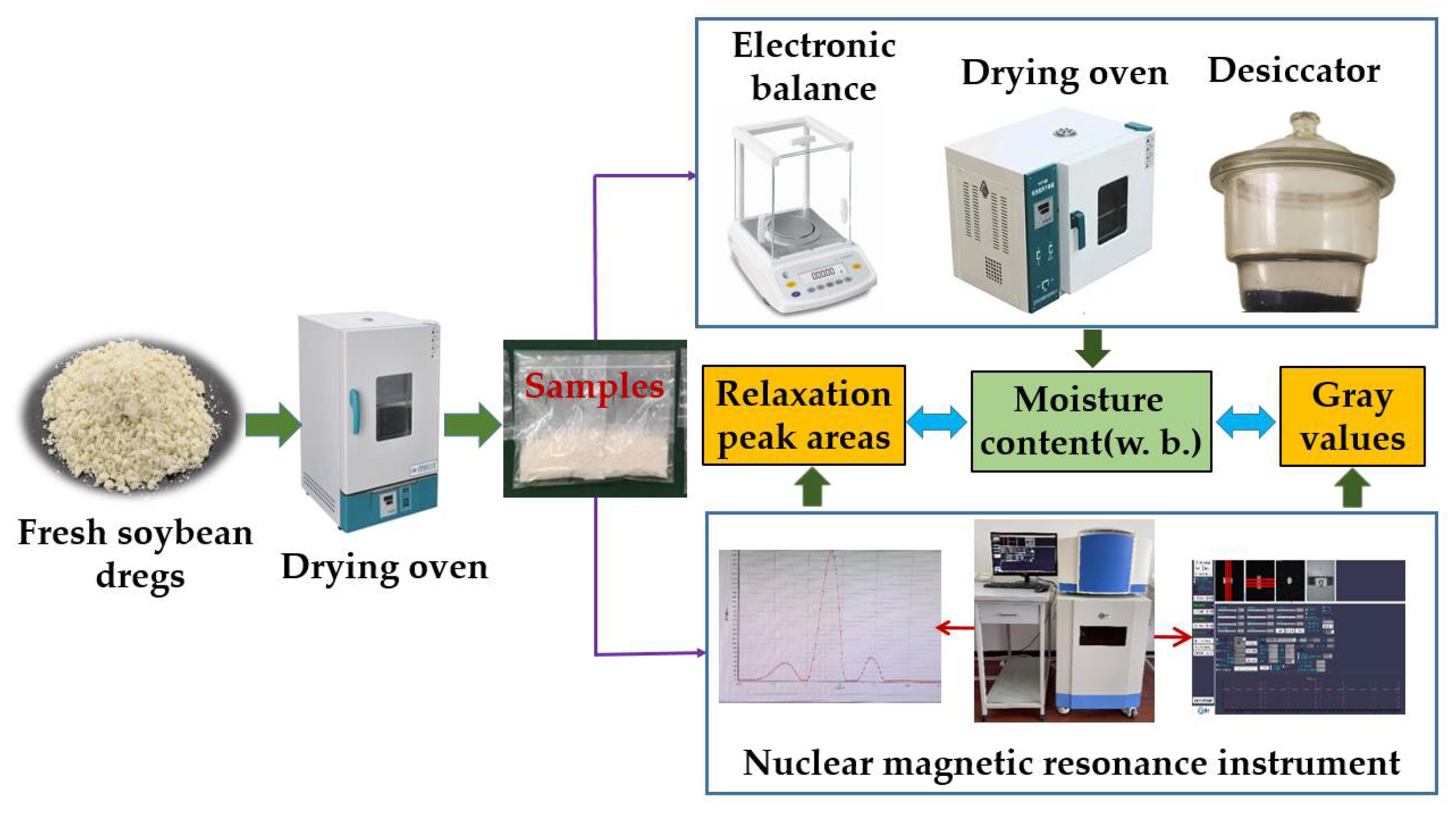
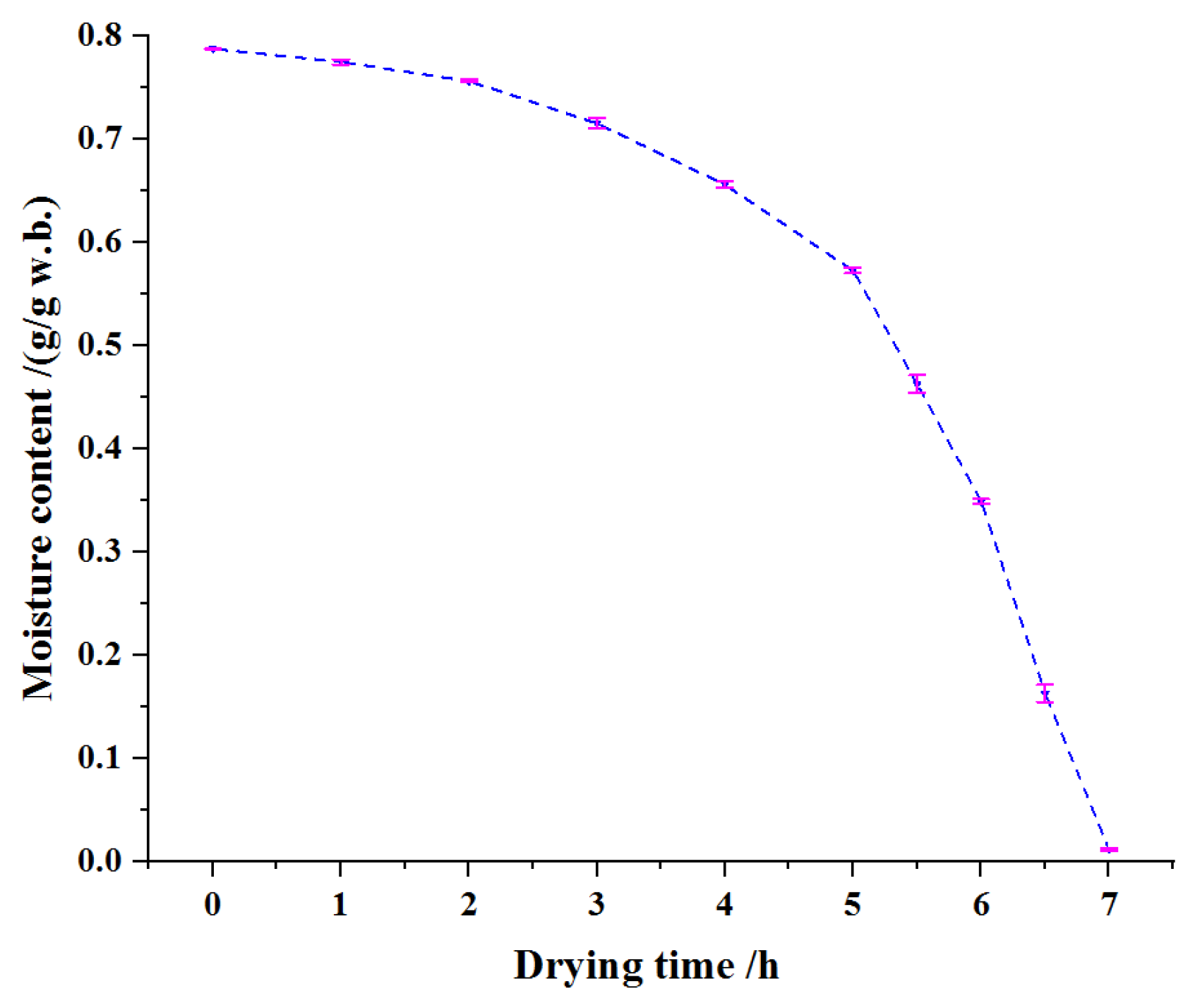
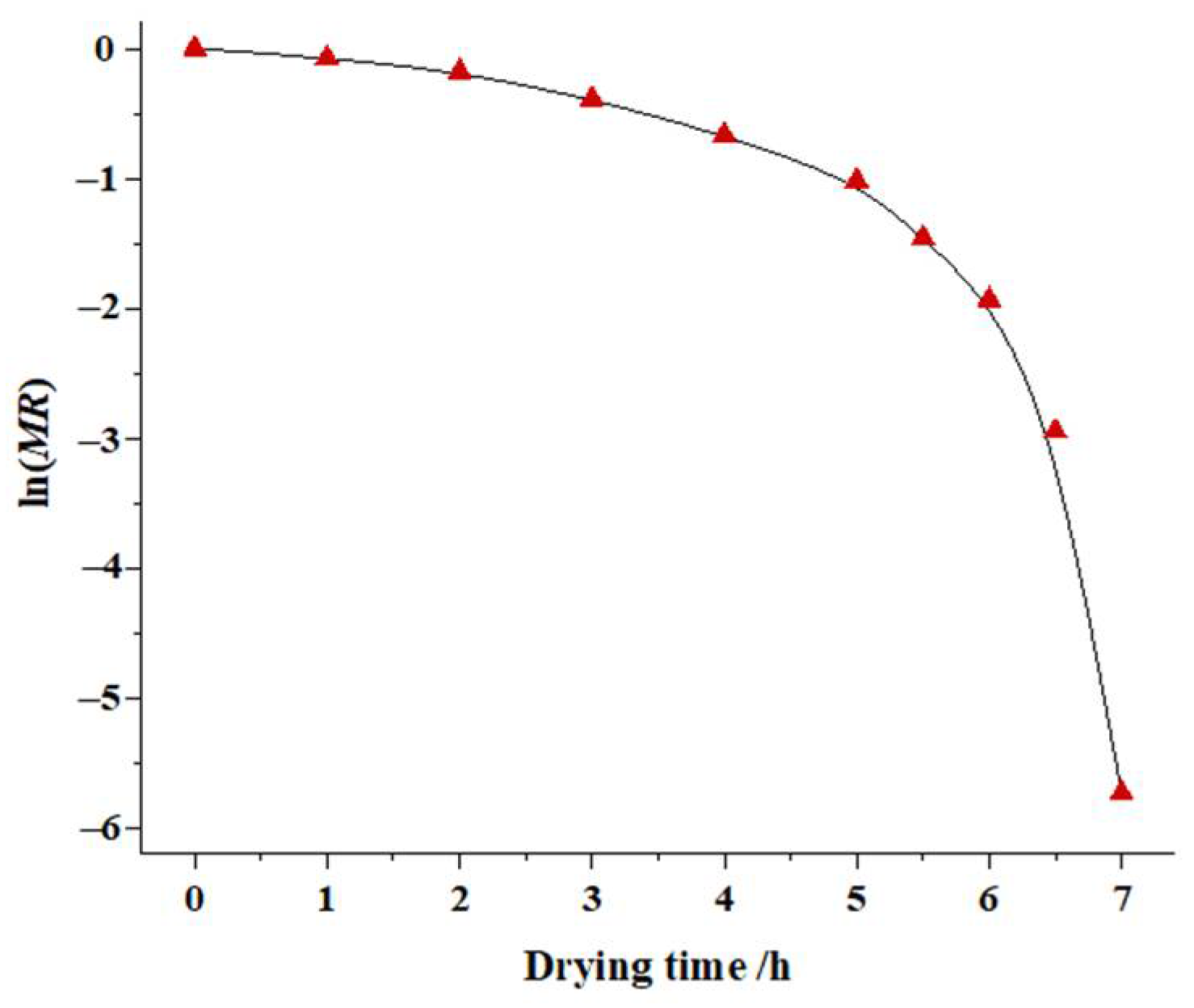

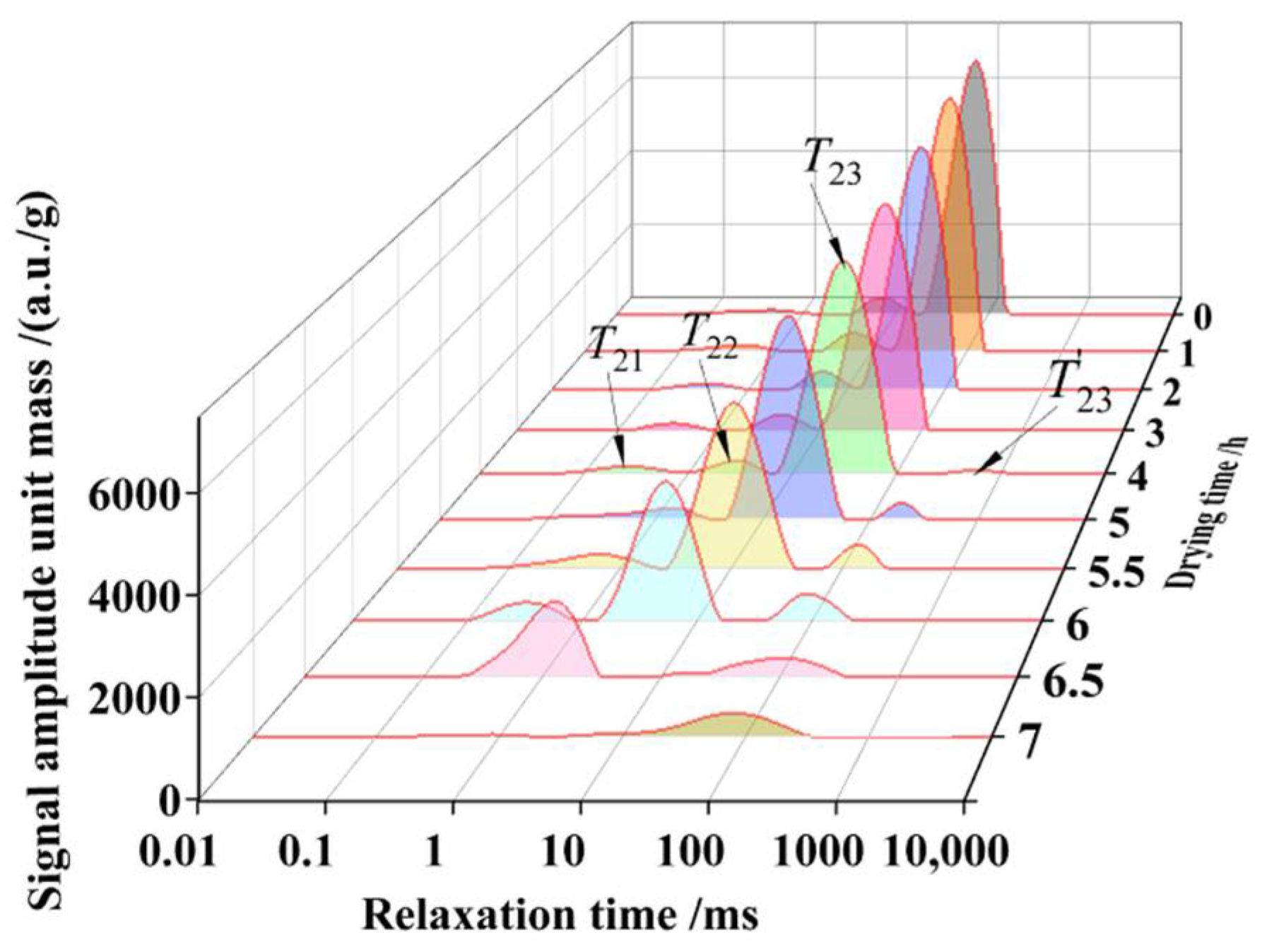
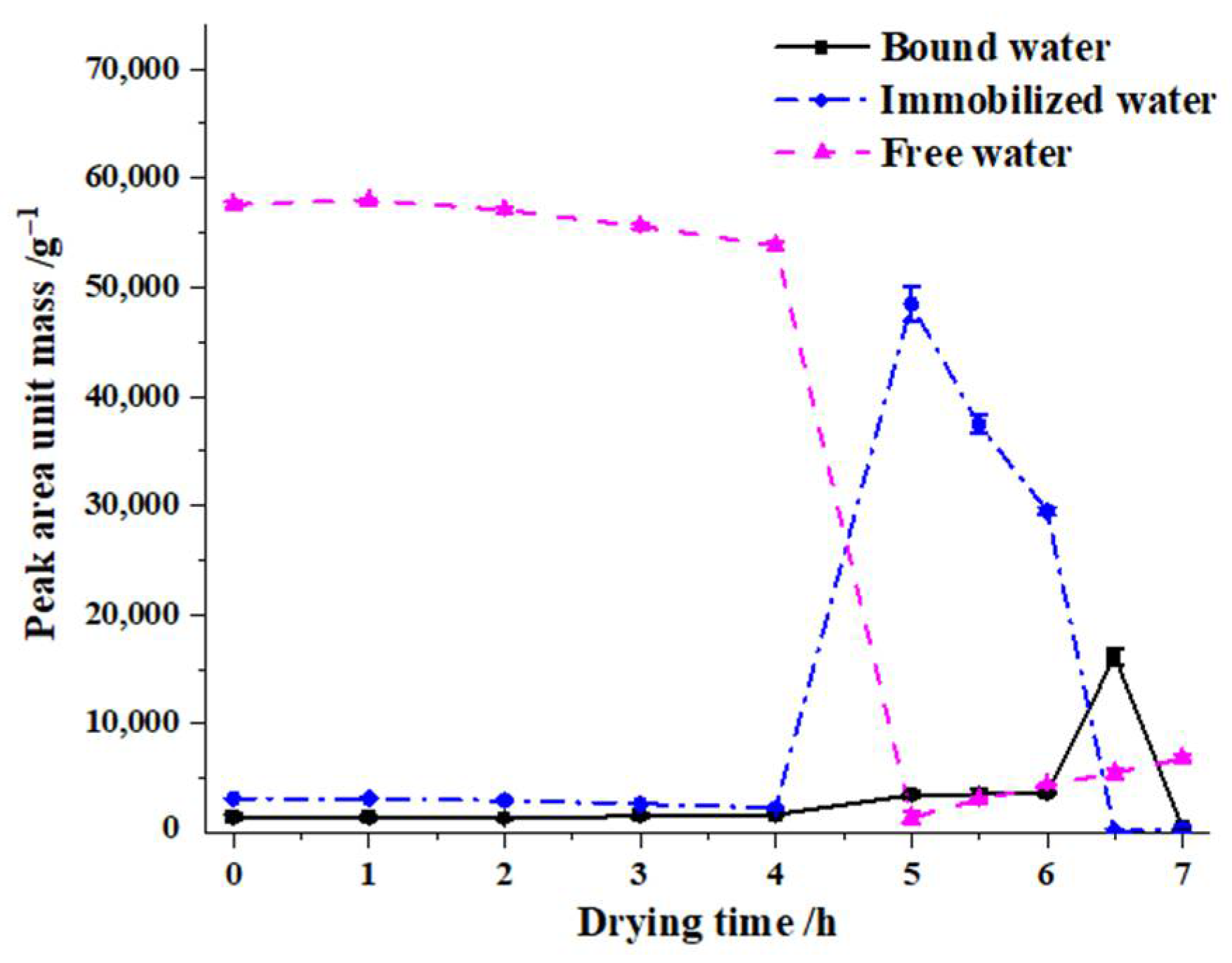
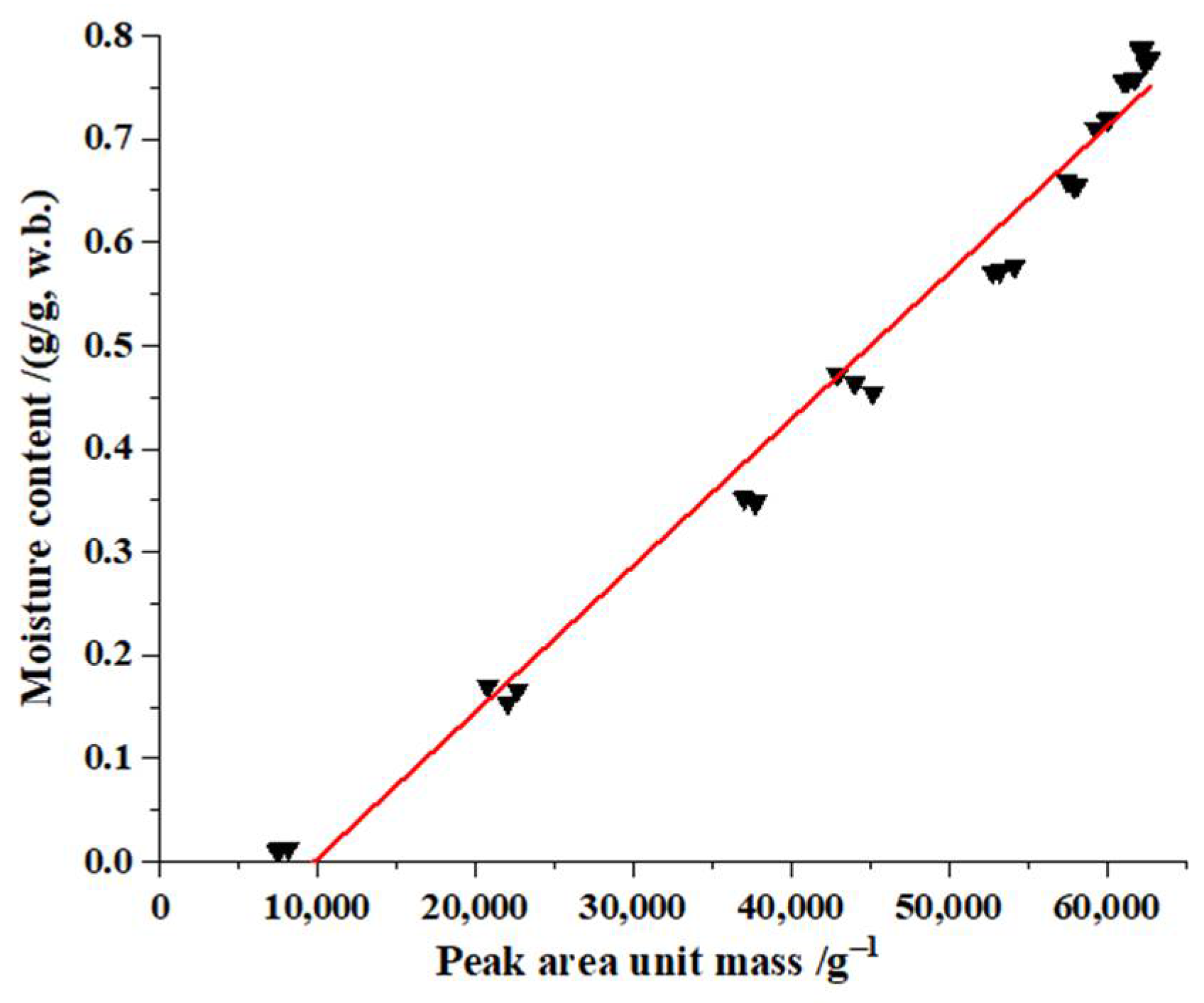

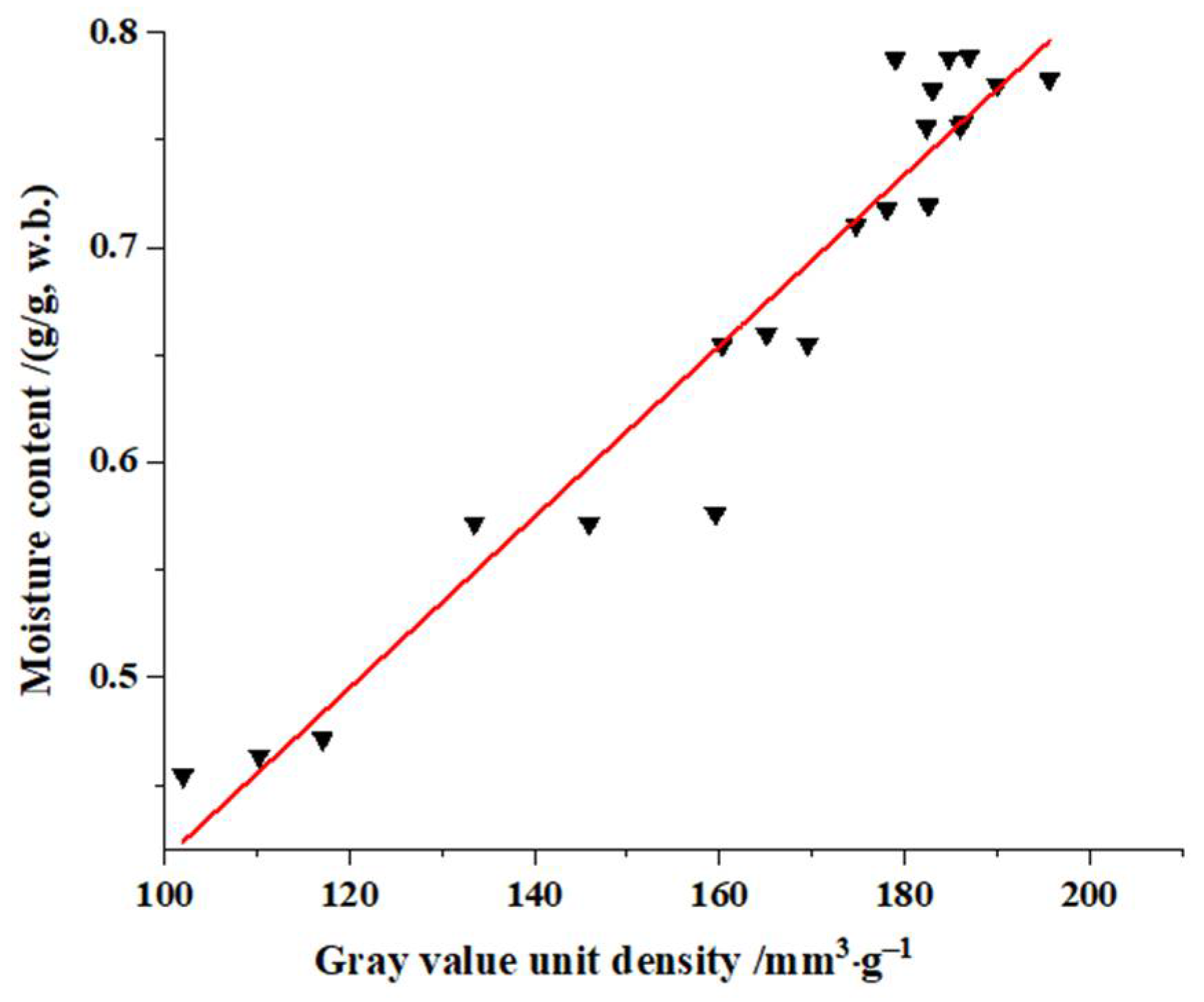
| Drying Time/h | T21/ms | T22/ms | T23/ms | T23’/ms |
|---|---|---|---|---|
| 0 | 0.48 ± 0.04 b | 7.06 ± 0.00 c | 69.08 ± 5.69 bc | - |
| 1 | 0.41 ± 0.03 b | 6.44 ± 0.53 c | 65.79 ± 0.00 bc | - |
| 2 | 0.40 ± 0.03 b | 5.34 ± 0.00 cd | 57.22 ± 0.00 bc | - |
| 3 | 0.31 ± 0.02 b | 4.04 ± 0.00 de | 43.29 ± 0.00 c | - |
| 4 | 0.25 ± 0.00 b | 2.79 ± 0.23 e | 29.90 ± 0.2.46 c | 487.33 ± 40.13 |
| 5 | 1.09 ± 0.58 a | 17.11 ± 1.41 a | 288.67 ± 151.98 a | - |
| 5.5 | 0.60 ± 0.09 b | 10.72 ± 0.00 b | 138.79 ± 11.43 b | - |
| 6 | 0.34 ± 0.03 b | 5.34 ± 0.00 cd | 91.32 ± 7.52 bc | 938.57 ± 130.67 |
| 6.5 | 1.26 ± 0.10 a | 16.3 ± 0.00 a | 100.00 ± 0.00 bc | - |
| 7 | 0.57 ± 0.35 b | 5.47 ± 2.74 cd | 79.42 ± 6.54 bc | - |
| Drying Time/h | Measured Moisture Content/(g/g, w.b.) | T2 Relaxation Signal | Hydrogen Proton Imaging | ||||
|---|---|---|---|---|---|---|---|
| Peak Area Unit Mass/g−1 | Predicted Moisture Content/(g/g, w.b.) | Predicted Error/% | Measured Gray Value | Predicted Moisture Content/(g/g, w.b.) | Predicted Error/% | ||
| 2.5 | 0.7435 | 61,327.98 ± 270.31 | 0.7309 | 1.69 | 179.64 ± 5.78 | 0.7332 | 1.39 |
| 4.5 | 0.6206 | 55,219.64 ± 343.20 | 0.6441 | 3.79 | 156.72 ± 12.77 | 0.6422 | 3.48 |
| 6.6 | 0.1317 | 19,930.19 ± 737.15 | 0.1430 | 8.58 | - | - | - |
Publisher’s Note: MDPI stays neutral with regard to jurisdictional claims in published maps and institutional affiliations. |
© 2022 by the authors. Licensee MDPI, Basel, Switzerland. This article is an open access article distributed under the terms and conditions of the Creative Commons Attribution (CC BY) license (https://creativecommons.org/licenses/by/4.0/).
Share and Cite
Chen, T.; Zhang, W.; Liu, Y.; Song, Y.; Wu, L.; Liu, C.; Wang, T. Water Status and Predictive Models of Moisture Content during Drying of Soybean Dregs Based on LF-NMR. Molecules 2022, 27, 4421. https://doi.org/10.3390/molecules27144421
Chen T, Zhang W, Liu Y, Song Y, Wu L, Liu C, Wang T. Water Status and Predictive Models of Moisture Content during Drying of Soybean Dregs Based on LF-NMR. Molecules. 2022; 27(14):4421. https://doi.org/10.3390/molecules27144421
Chicago/Turabian StyleChen, Tianyou, Wenyu Zhang, Yuxin Liu, Yuqiu Song, Liyan Wu, Cuihong Liu, and Tieliang Wang. 2022. "Water Status and Predictive Models of Moisture Content during Drying of Soybean Dregs Based on LF-NMR" Molecules 27, no. 14: 4421. https://doi.org/10.3390/molecules27144421





